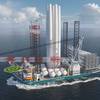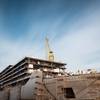The Specialists: A Quartet of S. Louisiana Yards Builds Most U.S. Crew/Supply Boats
The area directly south of Lafayette, La., is authentic bayou country, known for Cajun culture, excellent food, unique music and, for boat lovers, the crew/supply boat capital of the world. Four boat yards in this area build these multi-engine, all- aluminum, speedy vessels, almost exclusively. Each yard turns out up to six crew/supply boats a year.
In fact, three of the shipyards are located within just a few miles from each other in the tiny hamlet of Loreauville, La., a town that seems to be made up mostly of aluminum welders. That, of course, is an exaggeration, but not by much. Not every vessel delivered from these shipyards goes to work supporting the search for oil and gas, but those that don't are built on similar hulls and serve as excursion boats, small ferries or other passenger carrying vessels that benefit from all-aluminum construction.
The market for crew/supply boats is a direct reflection of drilling activity in the Gulf of Mexico (GOM). There have been boom times in the 1970's and early part of the 1980's, bad times in the mid-1980's and early 1990's and great times for the past few years.
Not only is drilling activity near record levels today, but as the oil and gas exploration activity moves deeper into the GOM, larger, faster and generally more capable crew/supply boats are needed to serve the rigs. Crew/supply boats fit into a unique niche in the industry. They haul crew, cargo and vital drilling fluids to the rigs. Generally smaller than their all-steel brethren the supply boat, crew/supply vessels do not have tanks large enough to carry liquid mud. They specialize in carrying fuel and potable or drill water.
In addition to be of all-aluminum construction and below deck tanks for fuel and water, crew/supply boats have these notable characteristics: ? Propulsion is typically 4-5 engines each producing 1,000-1,800 hp ? Seating for 65-100 passengers ? 145-170 ft. long, 28-34 ft. wide ? Aft rear open deck capable of carrying 250-400 tons of cargo. ? Props or waterjets powered ? Unattended engine rooms ? Coast Guard Certified, Subchapter T
A recent tour of the crew/supply boat yards has underscored the "boom" this part of the marine construction is experiencing. The one constant in all of these boat yards is the "Now Hiring" sign, posted conspicuously outside the offices. Breaux's Bay Craft, Loreauville, La. Since its founding in 1946, Breaux's Bay Craft has been making all kinds of boats. That variety still exists today. While 155-ft. and longer crew/supply boats are the mainstay of the facility, "We have probably have built more pilot boats that anyone," according to Hub Allums, manager of sales and engineering. "We just delivered a 58-ft. vessel," Allums added.
The yard now has four 155-160-ft.crew supply boats in the hull fabrication stage and one in the water preparing for a September delivery. The yard also has a 75-ft. pleasure boat in a fab shed being built "for a customer that wanted something better than a plastic boat," Allums said.
Earlier this year, Breaux's Bay Craft delivered two vessels to Crewboats, Inc., of Chalmette, La. Crewboats, Inc., owns 29 crew/supply boats. The 150-ft. Rig Runner and the 160-ft. Marathon Runner II were both delivered in the first half of 2001. Both are propelled by quad Caterpillar 3512 diesels generating a total of 5,600 hp driving Twin Disc gears. Both vessels also have 30-in. diameter Thrustmaster bow thrusters and can travel at 27 knots with a 110-ton load.
Crewboats, Inc. is also have Breaux Bay Craft build another "set" of these vessels for 2002 delivery. Also under construction is a 160-ft. long crew/supply vessel for Miller Marine of Trinidad, a long-term Breaux Bay Craft customer since the 1970's.
Seacor of Houston, Texas is also a major Breaux Bay Craft customer. The yard's next delivery will be to Seacor, a 155-footer scheduled to deliver in September. This vessel will be powered by five Cummins KT-38 engines each developing 1,400 hp. Secor has ordered another 155-ft. crew/supply vessel that will deliver late next year. That vessel is currently in hull construction.
Allums feels crew/supply boat construction will remain strong. He has every reason to feel confident. His corner office on the second floor overlooks four aluminum hulls under construction and the expectation that more business is on the way, as long, Allums says, "the price of oil stays up."
Breaux Brothers Enterprises, Loreauville, La. Joan, Vance and Ward Breaux seem to have a tiger by the tail in Loreauville. Driving into their boat yard presents somewhat of an obstacle course. To get to their office in the back of their facility, you have to weave around several crew/supply boats under construction all the while dodging trucks delivering aluminum sheets and all sorts of pieces and parts that make up today's modern crew boat. But the Breaux's don't mind this at all. Their yard is one of the busiest in Louisiana with a good mix of aluminum vessels. Recently delivered is a 100-ft. fishing vessel the Miss Celeste and a 50-ft. water taxi Bravo for Wendella Ltd. of Chicago. But, like the other boat yards in the area, the emphasis here is on crew/supply boats.
In April of 2001, Breaux Brothers Enterprises delivered the Mission Tide to Tidewater, Inc. The 155-ft. vessel left for Africa immediately after sea trials. In August the 155-ft. Mr. Jacob was delivered to Barry Graham Oil Service. This vessel is the latest delivery in a seven-boat order for Barry Graham. The company took delivery of two Breaux Brothers vessels in 1999 and two in 2000. Two more deliveries of these "workhorse" 155-footers will be made in 2002.
The 155-ft. crew/supply vessel is a specialty of Breaux "The seats we use today cost many times what we used to buy. They are wider, recline and have special features such as choice of music through a headset," Neuville said. Neuville compares the passenger compartments his yard is building today with the finish in many private yachts. "I expect we will add more features to the passenger compartment in response to customer demands."
Five Cummins KT-38's power the Jason K. McCall. Each engine generates 1,350 hp and is setup with Twin disc gears and four-blade propellers. Light ship speed is 27 knots. Cummins also supplied a pair of 99 kW generators for ships service. A 200 hp Thrustmaster 30-in. bow thruster aids the maneuverability of the vessel. It is powered by a 300 hp Cummins engine. The boat has sleeping accommodations for 14 crewmembers and messing for an additional 11 in the main deck galley area. Neuville has built several vessels for Seacor over the past few years. "All of the Seacor vessels are ABS classed so they can work anywhere in the world," said Kerry Neuville, president of Neuville Boat Works. Late last year the company added the Victor O. McCall to Seacor's fleet. This vessel is very similar to the more recent Jason K. McCall. It has the same Cummins engine package but carries few passengers and has slightly lower deck cargo capacity.
This vessel worked a few months in the Gulf before being transferred to Nigeria where there seems to never be enough boats. Neuville prides itself on build rugged yet good-riding boats. "We build a heavy boat and we think it is a good design for Seacor's needs, be it in the Gulf of Mexico or off the coast of Nigeria," Kerry Neuville said.
Other Activities Of course, other boat yards throughout the Gulf Coast area build crew/supply boats. Prominent among those yards is Swiftships Shipbuilders LLC, Morgan City, La.
This year Swiftships has delivered three quad jet 170-ft. crew/supply boats. The Candy Fleet, Morgan City, La. took delivery of the Candy Apple and Diamond Services, Amelia, La. has added the Wallace Glenn and the Miss Gracie to its fleet.. A 150-ft. waterjet vessel is also scheduled for delivery by the end of the year for Otto Candies LLC, a major offshore operator. Otto Candies have also ordered a pair of 150-ft. crew/supply boats from Austal USA, Mobile, Ala. Austal is a major fast ferry builder in Australia which recently opened a shipyard in Mobile to serve the U.S. market without running afoul of the Jones Act. Horizon Shipbuilding, Bayou La Batre, Ala., is building a pair of 155-ft. crew supply boats for SLOK Nigeria, adding to a growing contingent of U.S.-built crew/supply boats heading to Africa. Both boats are scheduled for delivery this year. C & G Boat Works, Bayou La Batre and Mobile, Ala., typically builds vessels for its own operating company, Graham Gulf, Inc. The have two vessels under construction in Bayou LaBatre and one in Mobile. One of the vessels in Bayou La Batre was recently sold to Tidewater, indicating the need of the major companies to get vessels into the Gulf as soon as possible. Janson Graham, president of C & G Boat Works and Graham Gulf, indicated he would start another vessel to replace the one sold to Tidewater.
Bigger, faster, greater cargo capacity, larger liquid tanks and more passenger compartment amenities are the major trends in crew/supply boats being built today. These trends are being driven by the longer voyages these vessels are taking to support the search for oil and gas in deeper water farther out in the Gulf of Mexico and other oil fields worldwide.
Hansen To Deliver 121-ft. Tug Hansen Boat Company is nearing completion of the 121ft. tug Phyllis Dunlap for Dunlap Towing Company of La Conner, Wash. Designed by Seattle-based Fisker-Anderson & Whalen, Inc., the Phyllis Dunlap will serve as a line-haul tug primarily for routes between Seattle and Western Alaska. She will be classed with American Bureau of Ships (ABS) and meets ABS Safety of Life at Sea (SOLAS) standards. The vessel has an overall length of 121.5 ft., molded beam of 38 ft., and will draw 16 ft. fully laden or 12 ft. light load. She is powered by a pair of Caterpillar 3606 diesels, providing a total of 5,080 hp. The 4:1 Haley reduction gears turn 11-in. diameter shafts with 10-ft. diameter three-blade stainless steel propellers inside fixed kort nozzles. The nozzles and triple rudder systems were furnished by NautiCAN Research & Development Ltd. Sound Propeller Services, Inc furnished the shafts and propellers.
Dunlap's new tug features Markey TBSD-34 diesel two-drum towing winch and a Markey DYSW-32-20 hydraulic single-drum hawser winch. Two Caterpillar 3304 diesel 105 KW gensets provide the vessel's auxiliary power.
The interior features separate galley and mess areas and accommodations for 10 crew, including mate's and captain's staterooms. "This has been an exciting project. Dunlap knows exactly what they need. So we've worked closely with them in order to insure this boat functions at its full potential. They've been a great customer," says Hansen Boat Company President Gary Hansen. Phyllis Dunlap is set to be launched on September 18.
Boston Whaler Forms Commercial, Govt Group The Brunswick Boat Group has formed Boston Whaler Commercial and Government Products to better focus on these important market segments. Fred Kiekhaefer has been named president of this new operating unit. Kiekhaefer also remains president of the Mercury Racing division. Boston Whaler Commercial and Government Products also will be working closely with Mercury Marine, Mercury Racing, and Valiant rigid hull inflatables to ensure seamless boat and engine package integration. Mercury, Mercury Racing and Valiant all remain independent units of Brunswick Corporation.
Production of Boston Whaler's commercial line will transition to a separate manufacturing facility in Edgewater, Fla., and should be completed by early October. During the transition, the new Boston Whaler Commercial and Government Products organization will remain at Boston Whaler's recreational boat facility in Edgewater. Boston Whaler President Mike Myers said that, although the new facility will manufacture and market boats under the Boston Whaler brand name, Commercial and Government Products will function as an independent business unit.
"Naturally the new unit will continue to manufacture the boats using Boston Whaler's traditional unsinkable Unibond construction process. Commercial Products also will use the superior components that maintain the integrity and reputation Boston Whaler enjoys," said Myers. "However, the commercial business will operate independently of the recreational business."










